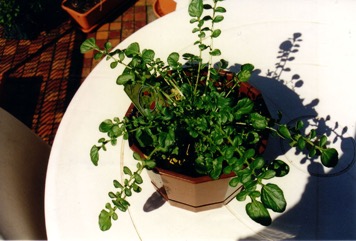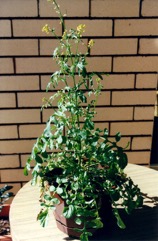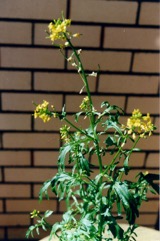Upland cress, Yellow rocket

A temperate plant. It grows along ditches, river banks, damp grasslands, waste places, roadsides, fields, disturbed sites between 700–4100 m altitude in China. It can grow in reasonably moist conditions. It does best in sun of partial shade. It responds to good fertility. It suits hardiness zones 6-10.
Also known as:
Barbara's cress, Land cress, Navadna barbica, Ou zhou shan jie, Wintercress
Synonyms
- Barbarea arcuata (Opiz ex J. Presl & C. Presl) Reichb.
- Barbarea vulgaris var. arcuata (Rchb.) Fr.
- Barbarea vulgaris var. brachycarpa Rouy & Foucaud
- Barbarea vulgaris var. longisiliquosa Carion
- Barbarea vulgaris var. sylvestris Fr.
- Campe barbarea (L.) W. Wight ex Piper
- Erysimum arcuatum Opiz ex J. Presl & C. Presl
- Erysimum barbarea L.
Edible Portion
- Leaves
Where does Upland cress grow?
Found in: Afghanistan, Albania, Algeria, Argentina, Armenia, Asia, Australia, Austria, Azerbaijan, Balkans, Belarus, Belgium, Bosnia, Britain, Bulgaria, Canada, Caucasus, Central Asia, China, Czech Republic, Denmark, Estonia, Europe, Finland, France, Georgia, Germany, Himalayas, Hungary, India, Iran, Iraq, Ireland, Italy, Kazakhstan, Korea, Kyrgyzstan, Latvia, Lithuania, Luxembourg, Mongolia, Nepal, Netherlands, New Zealand, North Africa, North America, Pakistan, Poland, Portugal, Romania, Russia, Scandinavia, Siberia, Sicily, Slovakia, Slovenia, South America, Spain, Sri Lanka, Sweden, Switzerland, Tajikistan, Tasmania, Tibet, Turkey, Turkmenistan, Tunisia, Ukraine, United States, Yugoslavia
Notes: There are 12 Barbarea species.
Growing Upland cress, Yellow rocket
Cultivation: Plants are grown from seed.
Edible Uses: The leaves have a hot peppery flavour useful in cooking. It can be used in salads, soups, sandwiches. Leaves from young rosettes in late winter when the weather is less frosty are less bitter. The later more bitter leaves need to be cooked in 2 or 3 changes of water.
Production: Leaves are normally picked nefore flowering. The leaves can become bitter in later spring. Covering the leaves near harvest to blanch them can reduce bitterness.
Nutrition Info
per 100g edible portion| Edible Part | Energy (kcal) | Protein (g) | Iron (mg) | Vitamin A (ug) | Vitamin c (mg) | Zinc (mg) | % Water |
|---|---|---|---|---|---|---|---|
| Leaves | - | - | - | - | 130 | - |
Upland cress, Yellow rocket Photos



References
W. T. Aiton, Hortus kew. ed. 2, 4:109. 1812
Beckstrom-Sternberg, Stephen M., and James A. Duke. "The Foodplant Database." http://probe.nalusda.gov:8300/cgi-bin/browse/foodplantdb.(ACEDB version 4.0 - data version July 1994) (As Campe barbarea)
Bircher, A. G. & Bircher, W. H., 2000, Encyclopedia of Fruit Trees and Edible Flowering Plants in Egypt and the Subtropics. AUC Press. p 54
Bodkin, F., 1991, Encyclopedia Botanica. Cornstalk publishing, p 132
Brickell, C. (Ed.), 1999, The Royal Horticultural Society A-Z Encyclopedia of Garden Plants. Convent Garden Books. p 160
Cerne, M., 1992, Wild Plants from Slovenia used as Vegetables. Acta Horticulturae 318
Cheifetz, A., (ed), 1999, 500 popular vegetables, herbs, fruits and nuts for Australian Gardeners. Random House p 37
Duke, J.A., 1992, Handbook of Edible Weeds. CRC Press. p 46
Elias, T.S. & Dykeman P.A., 1990, Edible Wild Plants. A North American Field guide. Sterling, New York p 99
Ertug, F, Yenen Bitkiler. Resimli Türkiye Florası -I- Flora of Turkey - Ethnobotany supplement
Esperanca, M. J., 1988. Surviving in the wild. A glance at the wild plants and their uses. Vol. 2. p 354
Facciola, S., 1998, Cornucopia 2: a Source Book of Edible Plants. Kampong Publications, p 52
Flora of China @ efloras.org Volume 8
Hedrick, U.P., 1919, (Ed.), Sturtevant's edible plants of the world. p 92 (As Barbarea arcuata)
Irving, M., 2009, The Forager Handbook, A Guide to the Edible Plants of Britain. Ebury Press p 80
Kiple, K.F. & Ornelas, K.C., (eds), 2000, The Cambridge World History of Food. CUP p 1885
Licata, M., et al, 2016, A survey of wild plant species for food use in Sicily (Italy) – results of a 3-year study in four Regional Parks. Journal of Ethnobiology and Ethnomedicine 12:12
Luczaj, L. et al, 2012, Wild food plant use in 21st century Europe: the disappearance of old traditions and the search for new cuisines involving wild edibles. Acta Soc Bot Pol 81(4):359–370
Lyle, K. L., 2010, The Complete Guide to Edible Wild Plants, Mushrooms, Fruits and Nuts. Falcon Guides. p 20
Mabey, R., 1973, Food for Free. A Guide to the edible wild plants of Britain, Collins. p 78
MacKinnon, A., et al, 2009, Edible & Medicinal Plants of Canada. Lone Pine. p 214
Plants for a Future database, The Field, Penpol, Lostwithiel, Cornwall, PL22 0NG, UK. http://www.scs.leeds.ac.uk/pfaf/
Redzic, S. J., 2006, Wild Edible Plants and their Traditional Use in the Human Nutrition in Bosnia-Herzegovina. Ecology of Food and Nutrition, 45:189-232
Redzic, S., 2010, Use of Wild and Semi-Wild Edible Plants in Nutrition and Survival of People in 1430 Days of Siege of Sarajevo during the War in Bosnia and Herzegovina (1992–1995). Coll. Antropol 34 (2010) 2:551-570
Saunders, C.F., 1948, Edible and Useful Wild Plants. Dover. New York. p 124,
Seidemann J., 2005, World Spice Plants. Economic Usage, Botany, Taxonomy. Springer. p 62
Simkova, K. et al, 2014, Ethnobotanical review of wild edible plants used in the Czech Republic. Journal of Applied Botany and Food Quality 88, 49-67
Urgamal, M., Oyuntsetseg, B., Nyambayar, D. & Dulamsuren, Ch. 2014. Conspectus of the vascular plants of Mongolia. (Editors: Sanchir, Ch. & Jamsran, Ts.). Ulaanbaatar, Mongolia. “Admon“ Press. 334pp. (p. 79-90).
USDA, ARS, National Genetic Resources Program. Germplasm Resources Information Network - (GRIN). [Online Database] National Germplasm Resources Laboratory, Beltsville, Maryland. Available: www.ars-grin.gov/cgi-bin/npgs/html/econ.pl (10 April 2000)
World Checklist of Useful Plant Species 2020. Royal Botanic Gardens, Kew
www.wildediblefood.com
Zhou Taiyan, Lu Lianli, Yang Guang; Ihsan A. Al-Shehbaz, BRASSICACEAE (CRUCIFERAE), Flora of China.